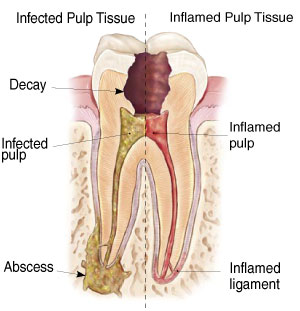DIAGNOSis:
Proper diagnosis is the most important part of your treatment. Oral pain such as toothaches or cracked/fractured teeth can often be difficult to pinpoint. Because of the vast network of nerves in the mouth, the pain of a damaged or diseased tooth often is felt in another tooth and/or in the head, neck or ear. An endodontist is a specialist in diagnosing and treating this type of pain.
ENDODONTIC THERAPY (ROOT CANAL):
A root canal is one of the most common dental procedures performed, with well over 14 million being performed every year. This simple treatment can save your natural teeth and prevent the need for dental implants or bridges.
At the center of your tooth is pulp. Pulp is a collection of blood vessels that helps to build the surrounding tooth. Infection of the pulp can be caused by trauma to the tooth, deep decay, cracks and chips, or repeated dental procedures. Symptoms of the infection can be identified as visible injury or swelling of the tooth, sensitivity to temperature or pain in the tooth and gums.
Endodontic therapy (root canal) is the process of removing this injured pulp from the inside of the tooth root. The root canal system is then thoroughly cleaned with a combination of mechanical debridement and chemical disinfection. Once cleaned the root canal system will be filled with a combination of gutta percha (rubber) and sealer (cement). Finally, the permanent restoration will be placed in your tooth to prepare your tooth for the final restoration, which will be done by your general dentist.
RETREATMENT (Root canal Revision):
Occasionally, a tooth that has undergone endodontic treatment fails to heal or pain continues despite therapy. Although rare, sometimes a tooth initially responds to root canal therapy but becomes painful or diseased months or years later. When either of these situations occurs, the tooth often can be maintained with a second endodontic treatment.
Treatment of Traumatic Injuries:
Pulp damage is sometimes caused by a blow to the mouth, and an endodontist specializes in treating these traumatic injuries. For example, a blow to a child's permanent tooth that is not fully developed can cause the root to stop growing. A procedure called apexification stimulates bone to be deposited at the end of the root,which makes it possible to then save the tooth through a root canal procedure. An endodontist is specially trained in procedures for replanting teeth that have been knocked out of their sockets.
Although most endodontic problems can be resolved by performing root canal therapy, there are occasions where surgical intervention is required. In these instances the affected area of the root is surgically removed.
Restorative Dentistry:
When your root canal is complete the tooth will require a permanent restoration. In most cases the final restoration will be placed in our office. This could be as simple performing a small filling or as complex as placing posts within the roots. In some cases your dentist may prefer to complete this portion of the treatment.
TMD/Myofacial Pain:
Myofacial pain is extremely common and often confused with dental pain. While not the primary focus of an endodontic practice, diagnosis and palliative treatment of these conditions are common. Treatment usually involves taking medication and fabrication of an occlusal guard.
Internal Bleaching:
It is not uncommon for a tooth requiring endodontic therapy to have a dark appearance. In these instances we can lighten your tooth from within.



